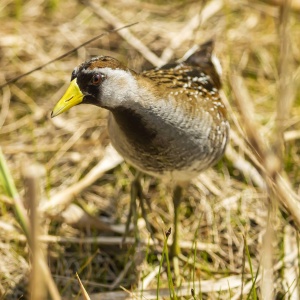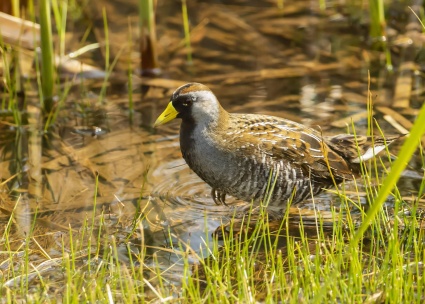Rails
|
|
Yellow Rail
(Coturnicops noveboracensis)
King Rail
(Rallus elegans)
Virginia Rail
(Rallus limicola)
Sora
(Porzana carolina)
UNCOMMON to COMMON; Migrates south for the winter. Randomly found in suitable habitat, Much more often heard rather than seen. Most easily seen in spring before the marshes begin to grow in. Soras are small, chubby, chicken-like birds with long toes. They have a stubby bill unlike other rails in the United States and Canada, which have longer bills. They frequently hold their short tail cocked up.
Soras are mottled gray and brown with white-edged feathers, but the feature that stands out the most is their yellow candy-corn bill. Other notable features include a black mask and throat patch, vertical white lines on the sides, and a white patch under the tail. Females tend to be less brightly colored than males and have less black on the face and throat. Juveniles also lack the black mask.
Soras walk through shallow wetlands pushing their head forward with every step while nervously flicking the tail upward, exposing the white undertail feathers. They tend to forage in dense vegetation, but also venture into open areas from time to time. Their long toes help them walk on top of floating mats of vegetation.
Soras make their homes in freshwater wetlands with emergent vegetation such as cattails, sedges, and rushes. During migration and winter, they also use brackish marshes, flooded fields, and wet pastures.
Common Gallinule
(Gallinula chloropus)
Common Gallinules are medium-sized marsh birds with long legs and toes. In profile, note the small head, thin neck, and small, thin bill. Swimming birds frequently hold their wings up, such that the wingtips stick up on the back.
Common Gallinules are mostly charcoal gray birds with a white stripe down their sides and white outer tail feathers. Adults have a bright red shield on their forehead and a red bill tipped in yellow. Immature birds look similar to adults, but lack the red shield and bill.
Common Gallinules swim like a duck, pushing their head forward, and walk on top of marsh vegetation like the rail they are. When they walk they tend to crouch down and slowly flick their tail up revealing white undertail feathers. They often stay close to emergent marsh vegetation, but swim out in the open from time to time.
They reside in freshwater or brackish marshes, ponds, and lakes with a mix of submerged, floating, and emergent vegetation and open water. They also forage in smaller ditches, canals, and rice fields.
American Coot
(Fulica americana)
The American Coot is a plump, chickenlike bird with a rounded head and a sloping bill. Their tiny tail, short wings, and large feet are visible on the rare occasions they take flight.
Coots are dark-gray to black birds with a bright-white bill and forehead. The legs are yellow-green. At close range you may see a small patch of red on the forehead.
You’ll find coots eating aquatic plants on almost any body of water. When swimming they look like small ducks (and often dive), but on land they look more chickenlike, walking rather than waddling. An awkward and often clumsy flier, the American Coot requires long running takeoffs to get airborne.
Look for American Coots at ponds in city parks, in marshes, reservoirs, along the edges of lakes, and in roadside ditches, sewage treatment ponds, and saltwater inlets or saltmarshes.

